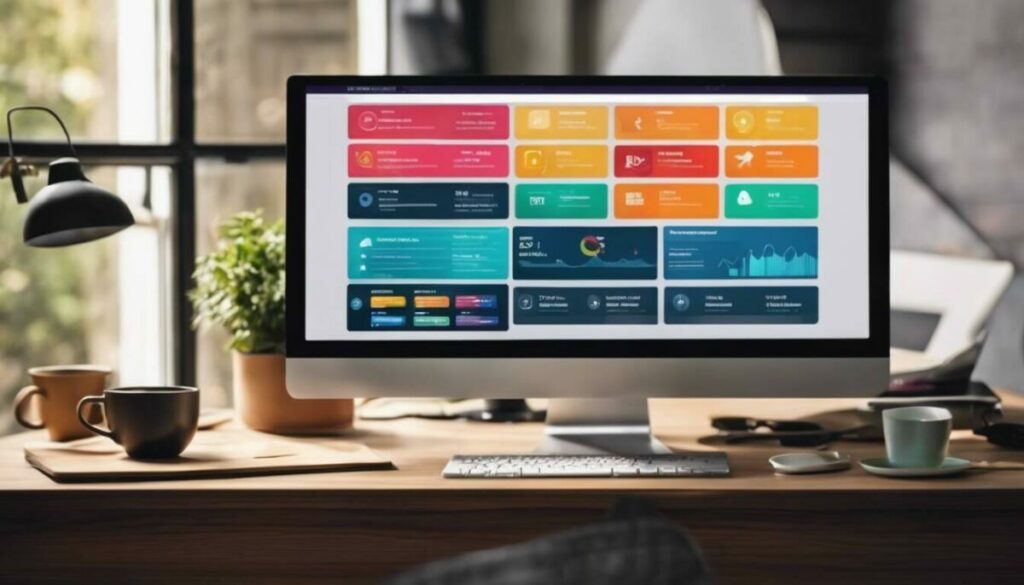A robust and consistent content update will play a significant role in your website’s visibility. Search engines indicate their penchant for fresh and relevant information, as it suggests active engagement with readers. Your blog might not be news-based that demands daily updates, but regularity is crucial even for evergreen contents like detailed guides to stay ahead in this competitive digital space. Therefore, don’t just count days, aim for quality and relevance. Now, let’s explore how this freshness impacts your site’s SEO status.
It is recommended to regularly review and update your content to ensure it remains relevant to your audience and aligns with current search intent. While there is no definitive frequency, monitoring rankings and traffic can help determine when updates are necessary.

Importance of Fresh Content
Imagine stumbling upon a website, and the last post is from over a year ago. It doesn’t quite fill you with confidence about the current status or relevance of the information, does it? In the world of websites and blogs, a similar sentiment holds true—fresh content matters.
When you update your website frequently, you send signals to search engines that your site is active and relevant. This encourages search engine crawlers to visit more often, potentially leading to more frequent indexing and consequently better visibility on search engine results pages (SERPs). More indexing means more chances for your content to be found by people searching for topics related to your niche.
Moreover, regularly updated content is key to engaging and retaining visitors. As they say in the world of digital marketing, “Content is king.” When you consistently provide valuable, up-to-date information, visitors are more likely to trust and return to your site. This can lead to higher conversion rates as visitors become customers or subscribers.
Take a blog that regularly uploads relevant, informative, and engaging posts, for instance. The consistency in publishing keeps loyal readers coming back for more. They anticipate new content and keep visiting the blog, increasing overall traffic and potentially boosting search engine rankings over time.
Another important aspect of updating your content frequently is the opportunity it provides to target new keywords. As search trends evolve, so do the ways people search for information. By regularly updating your content, you can incorporate these new keywords and phrases, expanding the potential reach of your website.
Additionally, consistent updates contribute to enhancing your site’s authority and topical relevance. Search engines value websites that demonstrate expertise in their respective fields through up-to-date and comprehensive content.
In essence, maintaining a cadence of fresh content on your blog not only keeps it relevant and engaging but also lays a strong foundation for effective SEO strategy. A high frequency of updates can significantly impact SEO performance; let’s now delve into the attributes of frequency and their effects on SEO.
Attributes of Frequency and Their Impact on SEO

The frequency of content updates is a pivotal factor that influences a website’s search engine optimization (SEO) performance. When determining how often you should update your blog or website, your industry and the type of content are significant considerations. For example, news and current events websites typically prioritize daily updates to stay relevant and competitive in their field.
The impact of content update frequency on SEO performance can vary based on a multitude of factors. Industries with high competition levels might require more frequent updates to keep up with competitors and maintain visibility in search results. This is particularly true for industries where trends, technologies, or regulations change rapidly, demanding an agile response through regular content updates. On the other hand, for industries with lower levels of competition or those focused on evergreen topics, less frequent updates may still maintain SEO performance. However, even in these cases, regular maintenance and occasional updates are essential to demonstrate ongoing website activity to search engines.
Moreover, the relevance of the updated content also plays a vital role in influencing the impact of frequency on SEO. If the updates align closely with user search intent and demonstrate the most current and accurate information, they are more likely to positively impact SEO performance.
Google’s algorithms are designed to prioritize recent and relevant content, with a demonstrated preference for websites that regularly refresh their pages. However, it’s important to note that while updating content can have positive effects on SEO performance, poorly executed or unnecessary updates can also lead to negative outcomes by diluting the overall quality and coherence of a website’s content.
Therefore, there is no one-size-fits-all approach when it comes to content update frequency. The dynamic nature of SEO demands a thoughtful and strategic approach tailored to each industry and specific content type.
With a deep understanding of the influence of content update frequency on SEO, it’s time to switch gears into exploring the tools available for monitoring and optimizing your content strategy.
Utilizing SEO Tools for Monitoring Content Updates

Monitoring and managing your content’s performance is crucial in maintaining a robust online presence. SEO tools play a pivotal role in providing insights into how your content is faring in the digital jungle. Let’s take a closer look at two primary tools—Ahrefs and Google Search Console—and how their features can aid you in your quest to keep your content fresh and relevant.
Ahrefs, a powerful SEO tool, offers a feature-rich Rank Tracker that enables you to track keyword rankings and analyze rank history. With its help, you can effortlessly monitor how well your content is performing for different keywords, and identify the ones that may need updating or optimization. By providing valuable insights into keyword positions over time, Ahrefs helps you stay on top of your content’s search engine performance and make informed decisions when it comes to content updates.
On the other hand, Google Search Console is an essential tool for any webmaster or SEO professional. It provides valuable data on the pages that rank for specific keywords, along with average position and click-through rate information. This allows you to identify which pieces of content require attention or updates, ensuring that your website continues to perform well in search engine results.
Both tools offer invaluable assistance in recognizing areas for improvement and optimization within your content. They are instrumental in ensuring that your website remains visible and accessible to your target audience by identifying areas that need attention. You can proactively address issues with your content before they become more significant problems down the line.
As we’ve seen, both Ahrefs and Google Search Console provide essential data and insights to keep your content updated and aligned with the ever-changing SEO landscape.
Strategic Planning for Scheduling Updates

When it comes to keeping your blog or website content fresh and optimized, having a strategic plan in place is crucial. This involves systematically identifying which pieces of content need updates, based on detailed analysis and concrete data.
One important factor in determining which content needs updating is keyword performance. By regularly checking how your target keywords are performing in search engine results, you can identify the pages that are losing traction and need attention. This data-driven approach allows you to prioritize updates more efficiently.
Creating a Content Calendar
Organizing and scheduling updates for different pieces of content can be effectively managed with the creation of a content calendar. This calendar helps in distributing the update workload over time, ensuring that all key pieces of content receive the necessary attention without becoming overwhelming.
This organized approach is essential for executing updates methodically, avoiding haphazard changes that may negatively impact search rankings.
For example, if you have seasonal content that needs periodic adjustments or a promotion tied to specific events, a content calendar ensures that these updates are scheduled ahead of time to align with relevant periods or seasons.
Aligning Update Frequency with Search Intent
The digital landscape is constantly evolving, and so are user search behaviors and preferences. Aligning your update frequency with shifts in search intent can be crucial for maintaining a competitive edge in your content strategy. For instance, if a certain topic experiences a surge in interest due to current trends, adapting your update schedule to capitalize on this increased search volume can significantly benefit your visibility and engagement.
Strategic planning for scheduling updates forms the backbone of an effective content maintenance strategy, ensuring that your content remains relevant, engaging, and aligned with evolving user search behaviors.
As we’ve seen how strategic planning plays a pivotal role in optimizing content freshness and relevance, let’s now delve into a compelling case study that quantifies the impact of regular content updates on SEO performance.
Case Study: Impact of Regular Content Updates on SEO

In a constantly evolving digital landscape, understanding the role of regular content updates in enhancing SEO performance is crucial. Let’s take a closer look at how a strategic approach to content updates can lead to improved search visibility and organic traffic.
Consider a scenario where a blog post experienced a decline in rankings and traffic due to changing search patterns and user preferences. This decline can be attributed to the evolution of search intent, which necessitated a reevaluation of the content’s relevance to user queries. Recognizing this shift in search intent, the content was revitalized through strategic updates, aligning it more closely with the evolving needs and expectations of users.
The revitalization process involved a comprehensive analysis of the existing content to identify areas for improvement. By integrating new insights into user behavior and preferences, the content was tailored to address emerging search intent effectively. This proactive approach positioned the content in alignment with the current requirements of search engine algorithms and user queries, laying the foundation for enhanced visibility and relevance.
As a result of these targeted updates, the blog post demonstrated significant improvements in search visibility, leading to higher organic traffic. This case study serves as a testament to the direct correlation between content update frequency and SEO performance. It showcases how regular updates, driven by an understanding of evolving search intent, can generate tangible improvements in rankings and overall content performance.
By examining real-life instances where strategic content updates have yielded positive results, we gain valuable insights into the impact of proactive maintenance on SEO outcomes. This case study reinforces the significance of staying attuned to shifting search patterns and user preferences, emphasizing the pivotal role of regular content updates in optimizing SEO performance.
Transitioning from understanding the impact of regular content updates on SEO to striking a harmonious balance between update frequency and content quality opens up new dimensions for effective digital presence management.
Balancing Update Frequency with Content Quality

Updating your blog regularly is crucial, but equally important is the quality of those updates. It’s like cooking a meal – you want to serve something both delicious and healthy. The same goes for your blog content. You want to provide high-quality, valuable information that keeps your readers coming back for more while also keeping search engines happy.
Quality matters: When it comes to your blog, what you say—your words and ideas—matters a lot. Google and other search engines aim to show their users the best, most relevant results. That means quality is key.
The combination of valuable and informative content and an active online presence can be seen as a recipe for online success. Just like you wouldn’t want stale bread or overcooked pasta, outdated, irrelevant content or low-quality updates may cause your website to lose its appeal and rankings.
Considerations for Balancing Quantity and Quality
Have you heard of the famous phrase, “content is king”? It’s often used in the blogging community because it’s true. The more valuable, informative, and well-written your content is, the more likely people will find it useful. But if you are updating just for the sake of updating without adding any real value, it won’t do much for you in terms of SEO performance.
Think of it this way: if you’re an artist, creating a painting every day might make people see that you’re working really hard – but if the art isn’t any good, they won’t buy it. The same concept applies to your blog posts. They need to be worth reading.
So, how do we keep up with good content while still updating frequently? Well, it all comes down to planning and strategy.
Now some people might argue that frequent updates mean sacrificing quality. But let me tell you something – with the right approach, frequent updates can lead to better quality.
Here are some tips on balancing update frequency with content quality:
- Plan Ahead: Schedule time to research, write, and edit your posts.
- Prioritize Useful Information: Keep your content informative, helpful, and relevant.
- Regularly Review Older Content: Make sure older posts are updated with fresh information.
- Ensure Accuracy: Fact-check your details to maintain credibility.
- Engage with Your Audience: Encourage comments and feedback from your readers.
- Diversify Your Content: Mix up your topics and writing styles to keep things fresh and interesting.
By focusing on providing comprehensive updates to ensure that the content remains useful and relevant to the target audience while upholding high standards of quality, a perfect balance can be achieved between update frequency and content quality for sustained SEO performance.
In essence, maintaining a delicate equilibrium between consistency and quality in content creation significantly underpins successful SEO endeavors. I wish you all the best in finding this balance in your blogging journey.

